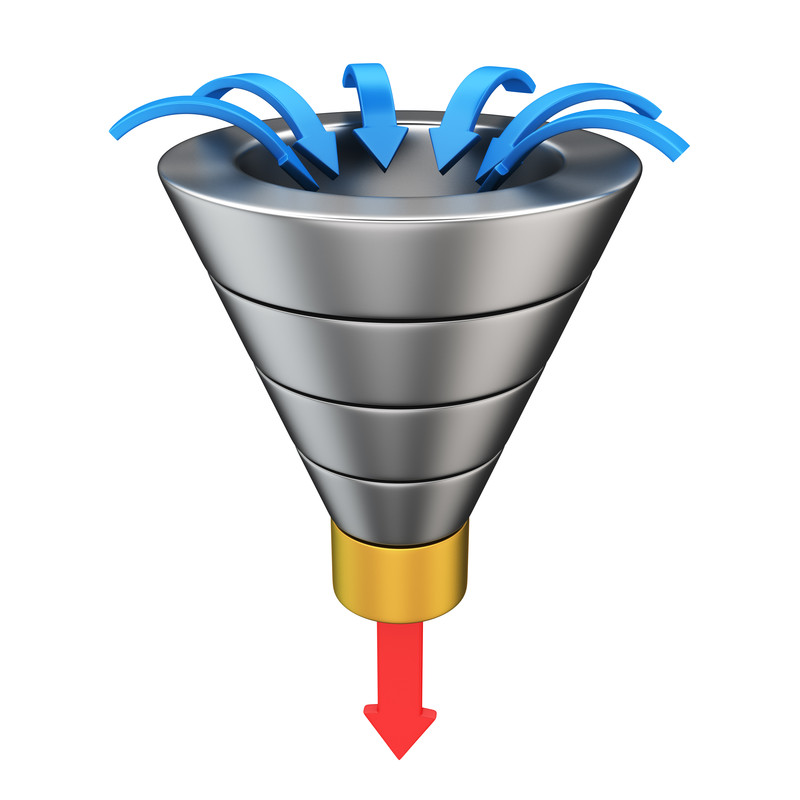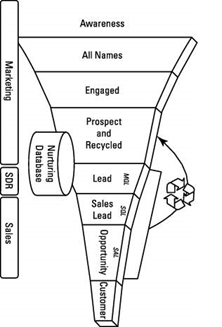
Generating leads is one of the most critical steps in sales and marketing for this is where businesses get their precious pool of prospects that can eventually become paying customers. Lead generation however involves a careful process that if done right can deliver a huge ROI at the fastest possible time. This process undergo what marketers call a Lead Generation Funnel.
Understanding the process and stages behind a lead generation funnel is critical for marketers to successfully move names and contacts gathered through their marketing efforts and turning them into customers. The following attempts to give you valuable insights in understanding the lead generation process as well as overviews on tips and best practices to make this lead generation funnel work for your brand and your business.
Understanding the Lead Generation Funnel
The sales and lead generation process is usually defined and described as a funnel. Like a real funnel, the process involve sifting through a large amount of names and prospects in the beginning, identify which of these names are viable as sales leads, then turning these leads into customers at the end of the funnel.

Dayna Rothman presents a good example of this lead generation funnel in her article “Lead Generation for Dummies”, presenting the process just like a literal funnel as shown in the diagram above. Dayna describes the funnel as a tool for defining who your best leads are and where they are in the lead generation process.
Getting a clear understanding of the process can help you optimize your campaigns to ensure these leads come out the end of the funnel as customers. However, it would be important to note that each business have its unique processes and sales situations. Their actual lead generation funnel may differ slightly from what is presented here, but for general intents and purposes the following describes the basic and most common stages involved in the sales funnel.
Stage 1: Awareness and Friend
Depending on how effective your inbound marketing is, the first stage of the lead generation process will generate a huge amount of traffic to your site. The goals here is to create awareness through social media marketing, SEO, paid advertising, and content marketing.
However, marketers need to be careful at this stage particularly when requiring first-contact visitors to sign up, fill up a form or register. Doing so too early in the process can turn off or scare away great prospects. On the other hand, you can also end up clogging your funnel with people who are prematurely engaged – and will eventually fall off further down the funnel.
Stage 2: All Names
The next stage involves officially entering names into your database, although at this point these names are not yet considered real leads. These are names your marketing efforts captured through a variety of ways, getting their contact information as well as their permission to communicate or market to them further.
Stage 3: Engaged
Getting names and contact information is your introductory window to prospective leads, enticing them to move through the lead generation process further by signing up to a newsletter, attend a webinar, downloading an ebook or accomplishing a lead capture form in a landing page, which leads to the next stage in the funnel – engagement.
It is important that your prospects go through this stage in the process before you attempt to move them through the funnel. Through engagement, you’re assured that your prospects knows that you are marketing to them and are open to your future communications and engagements with them.
Stage 4: Target or Prospects
If a contact engages with your marketing, you can now continue with the process and perform lead scoring to determine if this particular contact can be a viable lead or not. There are many ways you can perform lead scoring and these can be done both automatically and manually, depending on the type of business and prospects you are targeting.
Through lead scoring, you will know if a particular contact fits the profile of your ideal lead. Profile elements can be anything relevant to your need including job title, industry, size of company, etc. Once you’ve identifies a lead through scoring, you can then begin nurturing and other steps further down the funnel.
Stage 5: Marketing Qualified Lead
When a contact or target fits the profile of your lead and has been identified as having a high lead score, then you can qualify this particular lead for further marketing. First and foremost, this lead should have demonstrated considerable interest in your products and services to be deemed worthy of further marketing efforts and direct contact from your sales team, otherwise your campaign will just be flushed down the drain.
Stage 6: Recycled
Not all prospects can become a certified lead right away, but it doesn’t mean that if they did not become a lead the first time around they won’t be viable leads in the future. Such prospects may have demonstrated a certain level of interest in your products or services but at that particular point in time – was not ready to commit to a sale.
Such leads can be placed in your recycled leads database and nurtured by feeding them with continuous educational materials. Continue doing so until such time when they are ready to take the next step and become a qualified sales lead.
Stage 7: Sales Qualified Lead
Once a lead has demonstrated great interest in your products or services and have good engagement with your sales team, an account executive should then take over, engage directly with this sales qualified lead, and make a careful assessment if the prospect is truly a sales lead or would need further lead nurturing from marketing.
Stage 8: Opportunity
After an account executive identifies a prospect as a qualified sales lead, he or she can then identify the prospect further as a sales opportunity and will undergo further opportunity marketing. At this point, it would be important to understand that engaging with leads will incur cost, which include cost of engagement, conversion and opportunity marketing.
Stage 9: Customer
At this point, the lead you have engaged with and nurtured with further marketing has finally turned himself into a paying customer.
Again, it is important to reiterate that every company or organization have unique attributes and targeted audiences, so it would be best to identify which stages are applicable to your niche and make adjustments accordingly.
Proper Lead Management
Understanding what a lead generation funnel is and how it works is important to digital marketing, but it is also vital to note that success in these areas can only happen with proper lead management. Kimberly McCormick from Bayshore Solutions learned a great deal about these concepts on proper lead management after attending the Marketing Sherpa Lead Generation Summit and shared these in his article. Some of these learnings include:
- Treat leads as people and not just ordinary targets. Doing so, you can put into consideration that each person has unique behaviors that even some of the best practices in the industry may not apply
- If lead nurturing is not properly executed, prospects will not fall into the lead generation funnel and will actually fall out. This happens if particular stages in the funnel are not executed well to deliver the right results
- People are not programs that can easily be optimized by codes and scripts. They are driven by thought sequences that should be optimized through marketing
- To optimize thought sequences, marketing should under further engagement and conversation with prospects in order to generate a good value exchange that would lead these prospects towards your sales and marketing goals
3 Lead Generation Pillars
Proper lead management is focused on three pillars that serves as the backbone of your lead generation funnel. This includes:
- Lead Capture
To generate great results from your lead capturing efforts, you will need to understand the critical components particularly the Product you are marketing, the Message or the Presentation that you are sending out to prospects, and the channel from where all engagement will take place.
- Lead Qualification
Not all leads captured are viable or qualified as a sales-ready lead. So it is important that the prospects undergo lead qualification to determine if the lead can become a true marketing or sales-ready lead, which eventually can become an opportunity, or if the prospects needs further nurturing.
- Lead Nurturing
Lead nurturing is a process that gives marketers good insight on how to deliver the right kind of messages to the right kind of people at the proper time. This involves conversations, engagements and opportunity marketing from you sales and marketing group to determine interest, intimacy and intent insights from your prospects and leads.
In digital marketing, despite the fact that it undergoes various processes that involves the use of technology, you are still marketing to people, each having their own attributes and situations that affect their buying decisions. Lead generation funnel is a tool that puts this concept into great consideration, nurturing each unique lead according to their attributes, eventually leading these prospects and turning them into your ultimate goal – paying customers.
Jomer B. Gregorio is a well-rounded expert when it comes digital marketing. Jomer is also known as a semantic SEO evangelist and practitioner. Check out our Digital Marketing Services today and let us help you in achieving positive and profitable results for your business.
